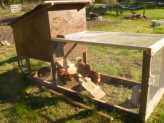Collecting Eggs for Hatching
Proper Care and Handling of Fertile Eggs
Collecting eggs for hatching requires special care. Before hatching fertile eggs in an incubator they need to be treated with respect.
Sometimes you have only one hen laying that you plan on hatching out the eggs from, so it can take a long time to collect enough for a clutch.
There is no problem with putting eggs from another hen, or even several hens to make up a decent sized clutch. She'll merrily try to hatch anything that even seems like an egg - even golf balls!
It's essential that you have a
rooster
to fertilize the eggs, as they won't form an embryo without this important step.
One mating can fertilize up to six to eight eggs, which are all in place ready to go, like a cluster of grapes. They don't form a shell until the day they are laid, they just have a soft membrane.
Fertile hatching eggs collected and stored correctly will be viable (hatchable) for up to ten weeks, though it’s recommended that you set them under the broody bantam hen or in an incubator within two weeks. If you plan on putting them in an incubator, put an 'x' on one side of the egg and an 'o' on the other to help determine which way to turn them.
You can also use the dowsing eggs technique to determine gender before wasting time and effort hatching out roosters.
Here are a few Tips on Collecting Eggs for Hatching:
Don’t bother saving eggs with defective shells – those that are rippled,
dimpled, shelly, or weak. You won’t have much success with incubating
them, and worst case scenario, they’ll explode in the incubator and you
have no idea how messy and smelly that can be until it happens to you.
Make
sure the nest that your hen is laying in is clean. Dirty eggs are hard
to clean, and can be a major cause of bacterial infection in the
incubator.
Cleaning Dirty Eggs
If you don’t need to clean them, don’t. The 'bloom' on the surface of the egg is beneficial at keeping out bad bacteria.
However,
if you only have a few eggs, you can clean them with warm water. Don’t
use cold water as this shrinks the membrane just inside the shell,
drawing in bacteria.
Run water from the tap until it’s hand warm to wash them, don’t soak them as the shell is actually permeable.
Some
people use a sterilant such as bleach or egg washing solution, but I
never worry too much about completely sterilizing them - the hen sure
doesn't concern herself if they have dirt on them.
Care of Eggs for Hatching
Keep the eggs at room temperature – not in a refrigerator.
The eggs should be stored point side slightly down, with the big end up. This prevents the yolk from sticking to the shell.
Turn
them three or more times a day. They should be turned end over end, not
rolled sideways. This stops the connecting string from getting tangled,
as well as preventing the chick from sticking to the shell - certain
death at hatching time.
Put them in a cardboard egg carton and lift one end of it up and switch the carton each turn.
When
you go to set them in the incubator, make sure you have adequately
warmed up the incubator. It can take between five hours and two or three
days to completely warm up and stay at the right temperature.
Still air incubators need to be a little warmer by a degree or two than those with a fan.
Rotate
the eggs in the incubator once set by rolling them end over end, not
sideways. The chorizae, or little strings holding the embryo in place
can get twisted if you just roll them.
You don’t need to do this if you have a
hen
incubating them, as she takes care of this.
Candling Eggs
This should be done at about eighteen days incubation, but can be done at any time after about ten days.
Practice this technique until you recognize which eggs are fertile, infertile, growing, or dead.
Using a strong flashlight and a tube to direct the beam, shine the light on the big end of the egg.
If the egg is completely clear, this means the egg is infertile and won’t hatch.
An air bubble at the large end is good, this means the chick is alive and the egg is exchanging air with the outside world.
A
completely dark egg most likely is partially developed and the chick is
now dead – these are the ones that blow up, so handle with care, and
dispose of it safely in your compost.
After the Hatch
Disposing of rotten eggs, defective eggs or dead chicks – these can be
disposed of in your hottest compost. Make a well in the center to put
them in where the heat will kill any bacteria.
Make sure you break the eggs as they will explode later, when you least expect it (when you spread the compost).
Cleaning the Incubator
This is important to do between hatches – clean the incubator
immediately after the hatch is finished and you’re sure there will be no
more hatching and the chicks are safely with mama hen or in a brooder.
Take
the incubator outside and rinse off the detritus from the chicks – it’s
amazing how much down they shed even in the two days that they are in
there.
Spray on a 10% solution of bleach on the bottom tray, rinse
off in a couple of minutes, and allow to dry completely before storing.
Wipe off the lid carefully; don’t get any moisture on the heater or any electrical parts.
Store
the incubator with the instructions for use if you have them in a dry
vermin proof place so it's ready to go next time you have some eggs to
hatch.
|
Looking for some great information on how to raise chickens, right in your own backyard? Now it's an accepted practice in many towns, as long as your hens are quiet and well behaved.
Get your flock started with the information in this e-book; instantly downloaded to your computer, you won't have to wait any longer:
|




New! Comments
Have your say about what you just read! Leave me a comment in the box below.